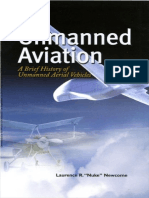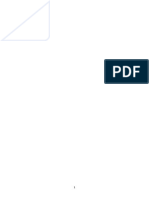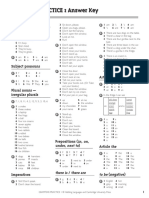K 87 009 - Print
K 87 009 - Print
Uploaded by
Victor MoraesCopyright:
Available Formats
K 87 009 - Print
K 87 009 - Print
Uploaded by
Victor MoraesOriginal Description:
Original Title
Copyright
Available Formats
Share this document
Did you find this document useful?
Is this content inappropriate?
Copyright:
Available Formats
K 87 009 - Print
K 87 009 - Print
Uploaded by
Victor MoraesCopyright:
Available Formats
MATERIAL SAFETY DATA SHEET
WALL COLMONOY CORPORATION
30261 Stephenson Hwy.
Madison Heights, Michigan 48071-1650
Phone: 248-585-6400 FAX: 248-585-7960
Section I. Identity:
Product Name: COLMONOY No. 225, 226, 227 and 228
(U.S.Patent Number 5,234,510)
MSDS Date: September 13, 2005
Section II. Ingredients/Identity Information:
COMPONENT CAS No. OSHA PEL ACGIH TLV Percent
Nickel 7440-02-0 1 mg/m3 1.5 mg/m3 80-95
Boron 7440-42-8 None None
Silicon 7440-21-3 10 mg/m3 10 mg/m3
Inert Materials Trade Secret None None
Section III. Physical/Chemical Characteristics
Boiling Point: Not applicable
Vapor Pressure: Not applicable
Vapor Density: Not applicable
Solubility: Negligible.
Specific Gravity (H20=1): 8.5
Melting Point: 2330 - 2380°F
Appearance and Odor: Silver/gray metallic powder, no distinct odor.
Section IV: Fire and Explosion Data
Flash Point and Method Used: None
Extinguishing Media: Do not use water on metal fires, use dry chemical, dry sand or
CO2 to smother fire.
Special Fire-Fighting Procedures: Do not breathe fumes. For large fires involving this
material, fire fighters should wear self-contained breathing apparatus.
Unusual Fire and Explosion Hazards: Fires or explosions may be initiated by
exposing any concentrated dust suspension in an enclosed area to a spark or flame.
This does not apply to product "as supplied" but to dust allowed to accumulate from
grinding or machining processes.
Product Name: COLMONOY No. 225, 226, 227, 228 Page 2 of 3
Section V. Reactivity Data
Stability: This product is stable.
Conditions to Avoid: Under special conditions, Nickel can react with carbon monoxide
in reducing atmospheres to form Ni (CO)4.
Incompatibility: Acids, strong oxidizing agents.
Hazardous Decomposition or Byproducts: During melting or spraying, nickel-oxide
fumes can be formed. Hazardous Polymerization: Will not occur.
Section VI. Health Hazard Data
Expected Route of Entry: Inhalation of fumes (when heated) would be main route of
exposure. Dust can be created if grinding or machining parts after heating.
Health Hazards (Acute and Chronic): Effects associated with over exposure to metal
dusts may include respiratory irritation, conjunctivitis, or pneumoconiosis. Repeated
handling can cause skin rash (dermatitis) in people sensitive to nickel.
Carcinogens: The National Toxicology Program (NTP) indicates that nickel and certain
nickel compounds may reasonably be anticipated to be carcinogens. IARC lists nickel
as possibly carcinogenic to humans.
Signs and Symptoms of Exposure: Sneezing, coughing, irritation of nose, throat or
eyes. Skin rash or itching.
Medical Conditions that May be Aggravated: Allergies or respiratory ailments.
Emergency and First Aid Procedures: Inhalation: Remove to fresh air. Skin
contact: Wash thoroughly with mild soap and water. Eyes: Flush with water until clear
of particles. Ingestion: If large amount, induce vomiting. If symptoms persist after any
route of exposure, seek medical attention.
Section VII. Precautions for Safe Handling and Use
Procedure in Case of Spill: Take up by wet sweeping or vacuum. If vacuum exhausts
to workplace, HEPA filters would be required. Do not create airborne dust. Place in
cover, labeled containers and save for re-use or disposal.
Waste Disposal Method: Normally reclaimed for scrap metal values. If disposal is
necessary, follow rules for regulated waste of this nature.
Precautions for Handling or Storing: Keep away from strong oxidizing agents. Avoid
repeated handling with bare skin. Do not eat or smoke in areas of use.
Section VIII. Control Measures
Respiratory Protection: If exposure limits are exceeded, wear NIOSH approved
respirator giving protection from dust or fume being generated. See OSHA “Respiratory
Protection Program, 29 CFR 1910.134.
Recommended ventilation: Good local exhaust with dust collection system needed
for spraying.
Colmonoy No. 225, 226, 227 and 228 Page 3 of 3
Gloves: If handling material is unavoidable, skin guard cream or work gloves are
advisable.
Eye Protection: Protective lenses, possibly shaded, appropriate for process being
performed. If grinding after welding, safety glasses or goggles should be worn.
Other: Wear clean, flame-resistant work clothing that is laundered separately.
General Health and Safety Warning: THE FOLLOWING IS A PRECAUTIONARY
STATEMENT THAT APPLIES TO ALL WELDING/BRAZING PRODUCTS; keep your
head out of the fumes. Use enough ventilation, exhaust at work, or both, to keep fumes
and gases from your breathing zone. See American National Standard Z49.1, “Safety
in Welding & Cutting” published by the American Welding Society, 550 N.W. LeJeune
Road, Miami, FL 33126 and OSHA 29 CFR 1910 available from the Superintendent of
Documents, U.S. Government Printing Office, P.O. Box 371954, Pittsburgh, PA 15250-
7954.
DOT Shipping Information: This product is not regulated for shipping.
HMIS Numbers:
Health: 1 Flammability: 0 Reactivity: 1
SARA Title III and Canadian Ingredient Disclosure List Information:
The following material is subject to the reporting requirements of Section 313 of
Title III of the Superfund Amendments & Reauthorization Act of 1986 and 40 CFR
Part 372. It also appears on the Canadian Ingredient Disclosure List:
Nickel.
State Warning Information:
California: This product contains a chemical known to the state of California to cause
cancer.
New Jersey: This product contains the following materials listed on the New Jersey
Right-To-Know Hazardous Substances List:
Substance 1341, nickel, CAS 7440-02-0, DOT No. None
Toxic Substances Control Act Certification:
This product complies with all applicable rules or orders under TSCA.
This sheet has been designed to meet the requirements of OSHA Hazard
Communication Standard 29 CFR 1910.1200 and OSHA Form 174
You might also like
- QC's SOPDocument11 pagesQC's SOPDavid See100% (1)
- SB-930 MSDSDocument4 pagesSB-930 MSDSOana-Maria OlingherNo ratings yet
- Msds For CharcoalDocument7 pagesMsds For CharcoalIrwan KraskalNo ratings yet
- Nicrobraz S BinderDocument3 pagesNicrobraz S BinderPixels MauricioNo ratings yet
- Spray Paint MsdsDocument4 pagesSpray Paint MsdsHillary RyanNo ratings yet
- 10 2514@4 868894Document181 pages10 2514@4 868894amerNo ratings yet
- Science: Common Atmospheric PhenomenaDocument33 pagesScience: Common Atmospheric PhenomenaMelanie Tagudin Trinidad80% (5)
- Magical Burst 5.0Document46 pagesMagical Burst 5.0ShlomiShafiroNo ratings yet
- Brassmsds 2007Document4 pagesBrassmsds 2007api-256162920No ratings yet
- Material Safety Data Sheet (MSDS) : Msds No: Aluminum Electrode REVISED 12-2009Document2 pagesMaterial Safety Data Sheet (MSDS) : Msds No: Aluminum Electrode REVISED 12-2009Rama Krishna Reddy DonthireddyNo ratings yet
- M - ENG - MSDS v1.2Document157 pagesM - ENG - MSDS v1.2sunthron somchaiNo ratings yet
- Niti Wire SdsDocument4 pagesNiti Wire Sdsfernieves1409No ratings yet
- Material Safety Data SheetDocument2 pagesMaterial Safety Data SheetghezelasheghiNo ratings yet
- MSDS Super Optimal 312Document5 pagesMSDS Super Optimal 312Patricio Aurea ZNo ratings yet
- BC 22msdsDocument2 pagesBC 22msdsdaretterNo ratings yet
- Rescocast 17EG MSDSDocument3 pagesRescocast 17EG MSDSRafael Rojas MeridaNo ratings yet
- Boron Nitrite MSDSDocument4 pagesBoron Nitrite MSDSRajaIshfaqHussainNo ratings yet
- Detector de HumoDocument7 pagesDetector de HumomarckalhiNo ratings yet
- MSDS Lutene-H Me2500Document4 pagesMSDS Lutene-H Me2500Abraham OrtegaNo ratings yet
- Sds Hpcsuper830Document8 pagesSds Hpcsuper830eltonNo ratings yet
- Material Safety Data Sheet: Brass Wire Brushes MSDS #12Document4 pagesMaterial Safety Data Sheet: Brass Wire Brushes MSDS #12LoveNo ratings yet
- 6% Cobalt Lin-All P.I. Drier (2009)Document6 pages6% Cobalt Lin-All P.I. Drier (2009)tpr314No ratings yet
- Material Safety Data Sheets (MSDS) : Hazardous Chemicals - Shamu Stadium, SeaWorldDocument18 pagesMaterial Safety Data Sheets (MSDS) : Hazardous Chemicals - Shamu Stadium, SeaWorldThe Orca Project CorpNo ratings yet
- Material Safety Data Sheet For Hobas PipeDocument3 pagesMaterial Safety Data Sheet For Hobas Pipejunhe898No ratings yet
- Material Safety Data Sheet Gold - Core Material: Section 1: Product and Company IdentificationDocument4 pagesMaterial Safety Data Sheet Gold - Core Material: Section 1: Product and Company Identificationfabiosan5No ratings yet
- Battery DryDocument4 pagesBattery DryBatanNo ratings yet
- BC BrickAndTileMSDS April2004Document5 pagesBC BrickAndTileMSDS April2004Alexi MilanNo ratings yet
- MSDS Molykote G-N Metal Assembly PasteDocument9 pagesMSDS Molykote G-N Metal Assembly PasteNikola PolimenovNo ratings yet
- MSDS NiCrDocument2 pagesMSDS NiCrBety FajriaNo ratings yet
- Material Safety Data Sheet: I. Product IdentificationDocument2 pagesMaterial Safety Data Sheet: I. Product IdentificationElMacheteDelHuesoNo ratings yet
- 62super Ti Se en 0Document4 pages62super Ti Se en 0Jhony MedranoNo ratings yet
- TruExterior MSDSDocument3 pagesTruExterior MSDS100livNo ratings yet
- TS Moly India Call +91-9885149412Document3 pagesTS Moly India Call +91-9885149412Project Sales CorpNo ratings yet
- Material Safety Data Sheets WDDocument5 pagesMaterial Safety Data Sheets WDWhitedove BatamNo ratings yet
- Hdpe MSDSDocument2 pagesHdpe MSDSAhmad Matin RifaldiNo ratings yet
- 2.-Phoenix 11101005 SDSDocument4 pages2.-Phoenix 11101005 SDSraul baltazar dominguiezNo ratings yet
- Msds - Asam Sulfat (H2so4)Document3 pagesMsds - Asam Sulfat (H2so4)ApriliaPuspitaSNo ratings yet
- Appendix 1b1 Fj9097.33-160 Msds A&b Finishednew2Document4 pagesAppendix 1b1 Fj9097.33-160 Msds A&b Finishednew2RUDDY ALFAN SUBAKTINo ratings yet
- Lsoh Sheath BlackDocument9 pagesLsoh Sheath BlackDanang AfriNo ratings yet
- Msds Al2o3 PDFDocument6 pagesMsds Al2o3 PDFNazuah Ushwatun HassanahNo ratings yet
- MSDS GraphiteDocument6 pagesMSDS Graphitepentalight100% (2)
- MSDS AluminumDocument14 pagesMSDS AluminumsachedalNo ratings yet
- Hematite - Material Safety Data Sheet: Section 1: Chemical Product and Company IdentificationDocument4 pagesHematite - Material Safety Data Sheet: Section 1: Chemical Product and Company IdentificationHabiiebb Aby Ramadhana AllazizztNo ratings yet
- Tungsten Electrodes MSDSDocument4 pagesTungsten Electrodes MSDSsalcabesNo ratings yet
- ParchesDocument6 pagesParchesEcuareencauche VascoNo ratings yet
- Msds - Nicrobraz Green Stop-Off Type II - InglesDocument3 pagesMsds - Nicrobraz Green Stop-Off Type II - InglesIvan CalderonNo ratings yet
- Prime Coat (PVT.) LTD: Rev: 3-4-2020 Ketonic Resin Pk-5851Document4 pagesPrime Coat (PVT.) LTD: Rev: 3-4-2020 Ketonic Resin Pk-5851khizer iqbalNo ratings yet
- Msds AluminaDocument6 pagesMsds AluminayaderNo ratings yet
- Whittemore Company Material Safety Data SheetDocument4 pagesWhittemore Company Material Safety Data SheetPao BarillasNo ratings yet
- Msds Carbonfoam Pu PirDocument5 pagesMsds Carbonfoam Pu PirAnonymous voA5Tb0No ratings yet
- MSDS Navigo 6 Co GBDocument8 pagesMSDS Navigo 6 Co GBSpyros NannosNo ratings yet
- Celcon Lw90-f2 BKDocument6 pagesCelcon Lw90-f2 BKalkanderNo ratings yet
- Elkon Products - Silica Fume MSDS, April 2013Document11 pagesElkon Products - Silica Fume MSDS, April 2013Sigit PurwandiNo ratings yet
- Msds Dow 732 Sealant PDFDocument7 pagesMsds Dow 732 Sealant PDFJake WestlakeNo ratings yet
- Carboline 890 Part ADocument6 pagesCarboline 890 Part AclintonNo ratings yet
- MSDS - Amuco - ParaloidDocument3 pagesMSDS - Amuco - ParaloidPaola MenaNo ratings yet
- MSDS CobaltDocument3 pagesMSDS CobaltBenny Samsul B.No ratings yet
- Aluminum OxideDocument9 pagesAluminum Oxideandi destianaNo ratings yet
- Hoja de Seguridad Interline 925 Componente ADocument10 pagesHoja de Seguridad Interline 925 Componente AdonaldoguerreroNo ratings yet
- Safety Data Sheet: According To EC Directive 91/155/EECDocument6 pagesSafety Data Sheet: According To EC Directive 91/155/EECSiti HannaNo ratings yet
- BURNDY Penetrox A PDFDocument4 pagesBURNDY Penetrox A PDFCarlos Gabriel Quintero RodríguezNo ratings yet
- MSDS Molykote 1000 PasteDocument9 pagesMSDS Molykote 1000 PasteNikola Polimenov100% (2)
- Dust Explosion and Fire Prevention Handbook: A Guide to Good Industry PracticesFrom EverandDust Explosion and Fire Prevention Handbook: A Guide to Good Industry PracticesNo ratings yet
- K 87 009 - Print PDFDocument4 pagesK 87 009 - Print PDFVictor MoraesNo ratings yet
- Frcme MDocument2 pagesFrcme MVictor MoraesNo ratings yet
- FN-XXX-ULX Series Cutsheet 06-2010 PDFDocument2 pagesFN-XXX-ULX Series Cutsheet 06-2010 PDFVictor MoraesNo ratings yet
- Sci - Short Circuit Isolator PDFDocument2 pagesSci - Short Circuit Isolator PDFVictor MoraesNo ratings yet
- HE Series 02-2012Document2 pagesHE Series 02-2012Victor MoraesNo ratings yet
- Sra - 24Document21 pagesSra - 24Victor MoraesNo ratings yet
- SPC 24 12 20Document2 pagesSPC 24 12 20Victor MoraesNo ratings yet
- Sci - Short Circuit IsolatorDocument2 pagesSci - Short Circuit IsolatorVictor MoraesNo ratings yet
- ATJ-EA - 02-2014 - Detector de Temperatura FixaDocument2 pagesATJ-EA - 02-2014 - Detector de Temperatura FixaVictor MoraesNo ratings yet
- ISCC 201 System Basics 3.0Document29 pagesISCC 201 System Basics 3.0ur42nate2875No ratings yet
- Establishing The Posterior Palatal Seal During The Final Impression StageDocument3 pagesEstablishing The Posterior Palatal Seal During The Final Impression Stageرلا رةنNo ratings yet
- By: Engr. Ronald John R. CajillaDocument1 pageBy: Engr. Ronald John R. CajillareynoldNo ratings yet
- Datsun Blue Bird Parts Catalog 410 411 1964 68Document20 pagesDatsun Blue Bird Parts Catalog 410 411 1964 68andrea100% (62)
- Immunization StatusDocument21 pagesImmunization StatusAubery RongNo ratings yet
- NEET-Enthuse - Phase 1 - Minor Test - 2 - 29.5.2024 - Q.P.Document31 pagesNEET-Enthuse - Phase 1 - Minor Test - 2 - 29.5.2024 - Q.P.aahanacharanNo ratings yet
- High Tensile Stock ListDocument68 pagesHigh Tensile Stock ListJJ FloresNo ratings yet
- StandardDocument3 pagesStandardjonh dickNo ratings yet
- Dye & Dye Intermediate IndustryDocument9 pagesDye & Dye Intermediate IndustrymustafaNo ratings yet
- Basic Principles of MagnetsDocument24 pagesBasic Principles of MagnetsMarife GuadalupeNo ratings yet
- St. Joseph Novena Day 7Document3 pagesSt. Joseph Novena Day 7Breezy Buzy OnNo ratings yet
- 1.timing Optimization Techniques: 1. MappingDocument152 pages1.timing Optimization Techniques: 1. MappingPraveen Kumar100% (1)
- Catalogo Solo CBN Serie 3000Document230 pagesCatalogo Solo CBN Serie 3000LEONARDO DIAZNo ratings yet
- Chrysler JX Stratus Sebring Convertible LHD RHD 1997 Service Manual Ignition SystemDocument28 pagesChrysler JX Stratus Sebring Convertible LHD RHD 1997 Service Manual Ignition SystemjjrmgNo ratings yet
- Grammar Practice Level1 Answer KeyDocument7 pagesGrammar Practice Level1 Answer KeyWisrut MueangkaeoNo ratings yet
- Echoes Spring 2019Document46 pagesEchoes Spring 2019mattlaneNo ratings yet
- Holistic DevelopmentDocument16 pagesHolistic DevelopmentArtem ParriñasNo ratings yet
- Bukidnon phrase-WPS OfficeDocument9 pagesBukidnon phrase-WPS OfficeSofiáNo ratings yet
- 251 North Bridge Road Singapore 179102 Visit Us at "WWW - Lta.gov - SG"Document2 pages251 North Bridge Road Singapore 179102 Visit Us at "WWW - Lta.gov - SG"YADI JAYADINo ratings yet
- Carmichael 1957Document12 pagesCarmichael 1957Anhar AnharNo ratings yet
- Crompton Blue Chip Case Study.Document11 pagesCrompton Blue Chip Case Study.KinjalBhadreshwara0% (2)
- Chap 3.7 Seagrass EcosystemDocument96 pagesChap 3.7 Seagrass Ecosystemsuganya rameshNo ratings yet
- Ergonomics of A Laptop and Notebook PCDocument19 pagesErgonomics of A Laptop and Notebook PCPooja RawatNo ratings yet
- Leadership in The Digital EraDocument9 pagesLeadership in The Digital EratheDragongaming 201No ratings yet
- Case Presentation DVTDocument26 pagesCase Presentation DVTimad mokalledNo ratings yet

































































































